Social Expectation and Changes in Behavior
VerifiedAdded on 2022/11/28
|7
|1728
|387
AI Summary
This essay discusses the ways in which social expectations and spatial distances determine the behavior of individuals in society. It reviews the works of Kitchin and Cresswell on social inclusion, exclusion, and oppression, and explores the role of space and place in a media event related to socio-spatial order.
Contribute Materials
Your contribution can guide someone’s learning journey. Share your
documents today.
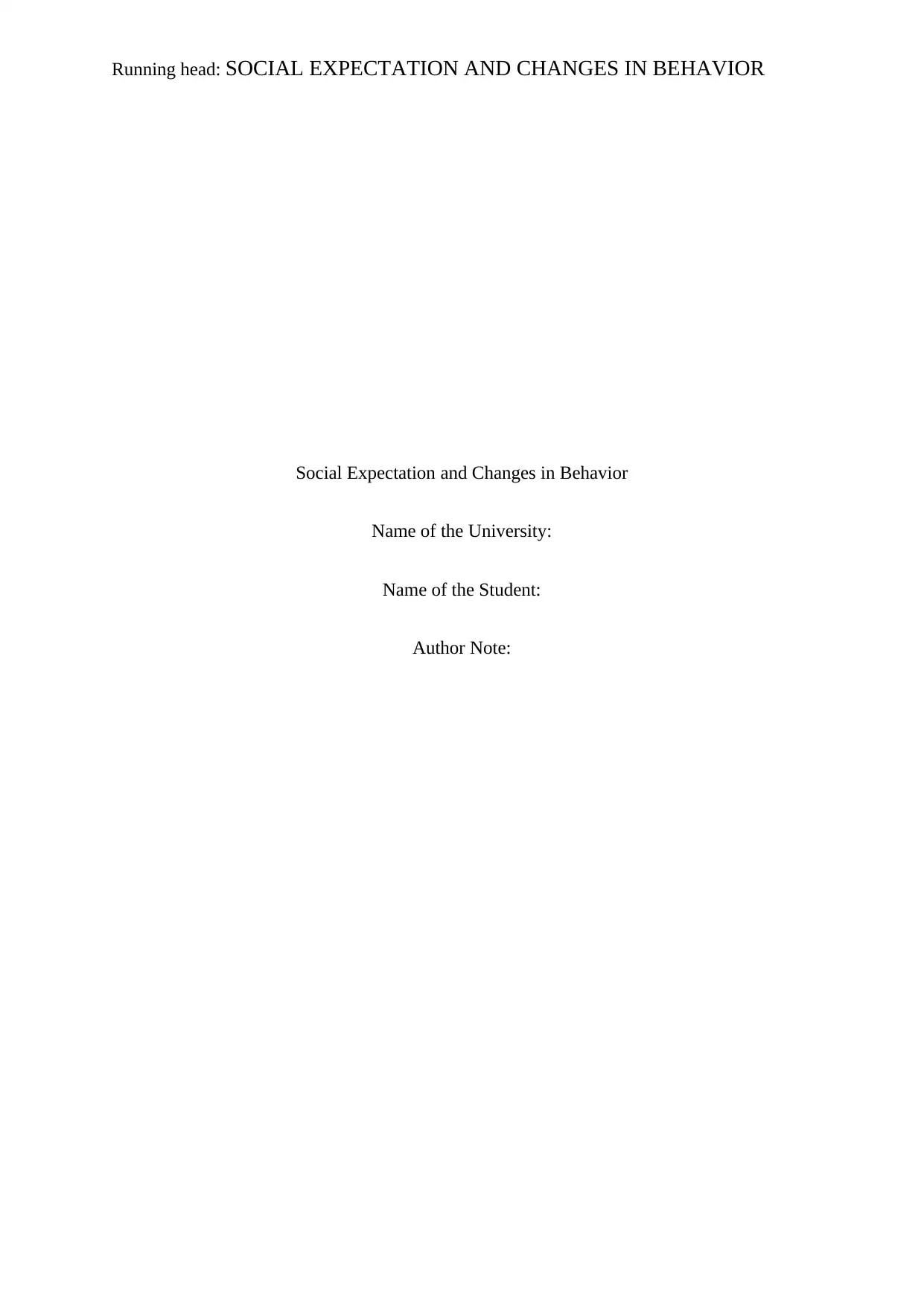
Running head: SOCIAL EXPECTATION AND CHANGES IN BEHAVIOR
Social Expectation and Changes in Behavior
Name of the University:
Name of the Student:
Author Note:
Social Expectation and Changes in Behavior
Name of the University:
Name of the Student:
Author Note:
Secure Best Marks with AI Grader
Need help grading? Try our AI Grader for instant feedback on your assignments.
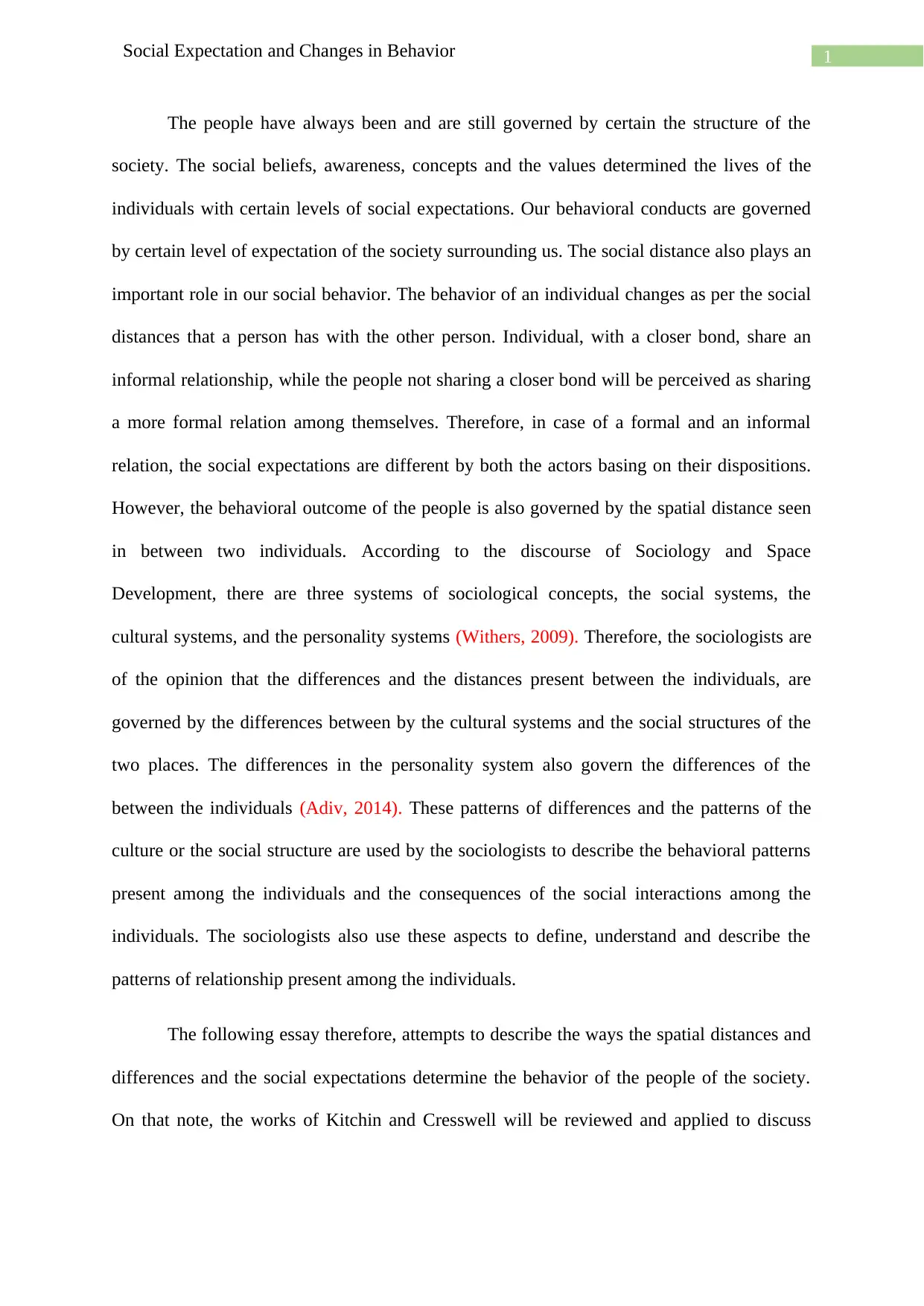
1Social Expectation and Changes in Behavior
The people have always been and are still governed by certain the structure of the
society. The social beliefs, awareness, concepts and the values determined the lives of the
individuals with certain levels of social expectations. Our behavioral conducts are governed
by certain level of expectation of the society surrounding us. The social distance also plays an
important role in our social behavior. The behavior of an individual changes as per the social
distances that a person has with the other person. Individual, with a closer bond, share an
informal relationship, while the people not sharing a closer bond will be perceived as sharing
a more formal relation among themselves. Therefore, in case of a formal and an informal
relation, the social expectations are different by both the actors basing on their dispositions.
However, the behavioral outcome of the people is also governed by the spatial distance seen
in between two individuals. According to the discourse of Sociology and Space
Development, there are three systems of sociological concepts, the social systems, the
cultural systems, and the personality systems (Withers, 2009). Therefore, the sociologists are
of the opinion that the differences and the distances present between the individuals, are
governed by the differences between by the cultural systems and the social structures of the
two places. The differences in the personality system also govern the differences of the
between the individuals (Adiv, 2014). These patterns of differences and the patterns of the
culture or the social structure are used by the sociologists to describe the behavioral patterns
present among the individuals and the consequences of the social interactions among the
individuals. The sociologists also use these aspects to define, understand and describe the
patterns of relationship present among the individuals.
The following essay therefore, attempts to describe the ways the spatial distances and
differences and the social expectations determine the behavior of the people of the society.
On that note, the works of Kitchin and Cresswell will be reviewed and applied to discuss
The people have always been and are still governed by certain the structure of the
society. The social beliefs, awareness, concepts and the values determined the lives of the
individuals with certain levels of social expectations. Our behavioral conducts are governed
by certain level of expectation of the society surrounding us. The social distance also plays an
important role in our social behavior. The behavior of an individual changes as per the social
distances that a person has with the other person. Individual, with a closer bond, share an
informal relationship, while the people not sharing a closer bond will be perceived as sharing
a more formal relation among themselves. Therefore, in case of a formal and an informal
relation, the social expectations are different by both the actors basing on their dispositions.
However, the behavioral outcome of the people is also governed by the spatial distance seen
in between two individuals. According to the discourse of Sociology and Space
Development, there are three systems of sociological concepts, the social systems, the
cultural systems, and the personality systems (Withers, 2009). Therefore, the sociologists are
of the opinion that the differences and the distances present between the individuals, are
governed by the differences between by the cultural systems and the social structures of the
two places. The differences in the personality system also govern the differences of the
between the individuals (Adiv, 2014). These patterns of differences and the patterns of the
culture or the social structure are used by the sociologists to describe the behavioral patterns
present among the individuals and the consequences of the social interactions among the
individuals. The sociologists also use these aspects to define, understand and describe the
patterns of relationship present among the individuals.
The following essay therefore, attempts to describe the ways the spatial distances and
differences and the social expectations determine the behavior of the people of the society.
On that note, the works of Kitchin and Cresswell will be reviewed and applied to discuss
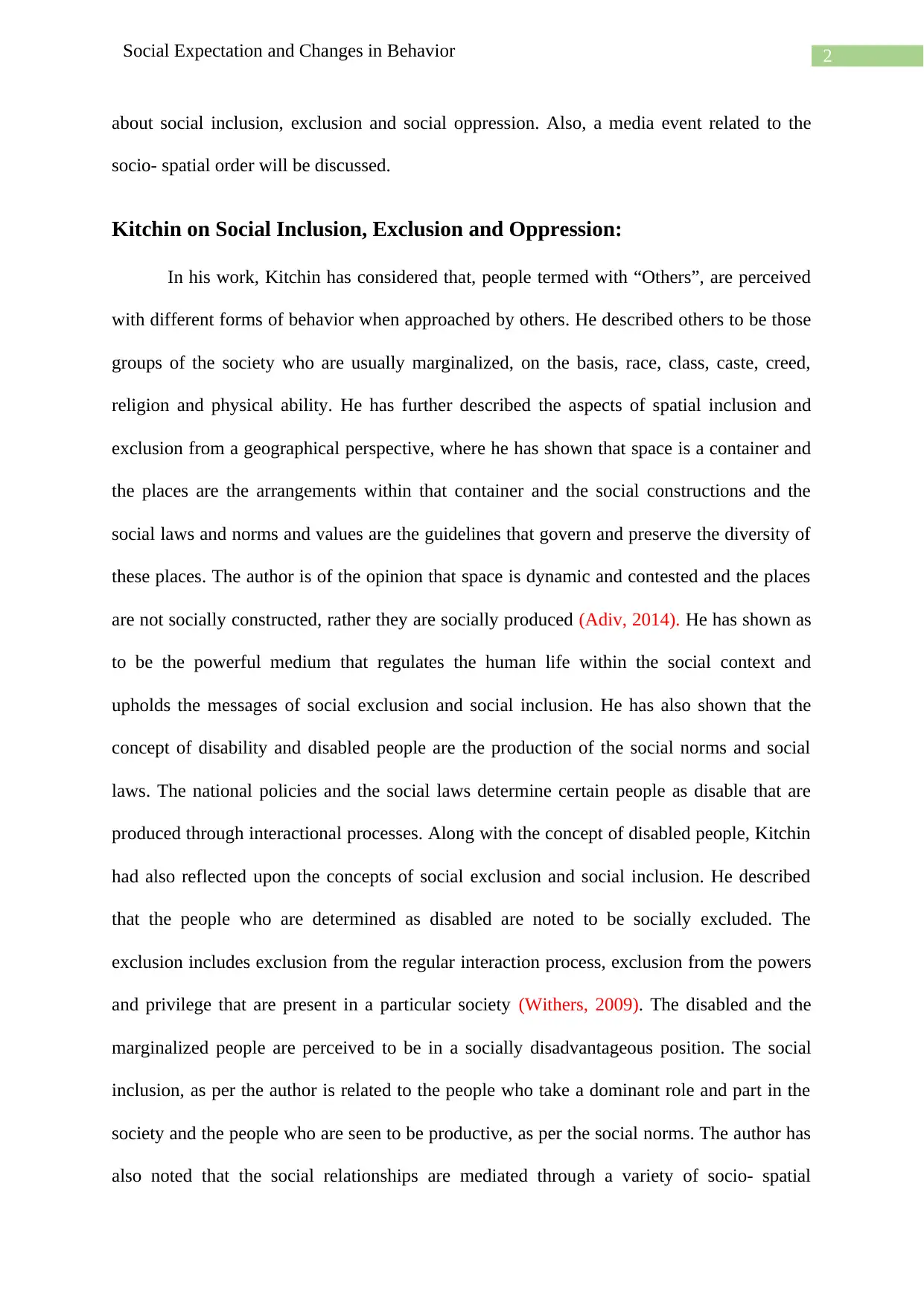
2Social Expectation and Changes in Behavior
about social inclusion, exclusion and social oppression. Also, a media event related to the
socio- spatial order will be discussed.
Kitchin on Social Inclusion, Exclusion and Oppression:
In his work, Kitchin has considered that, people termed with “Others”, are perceived
with different forms of behavior when approached by others. He described others to be those
groups of the society who are usually marginalized, on the basis, race, class, caste, creed,
religion and physical ability. He has further described the aspects of spatial inclusion and
exclusion from a geographical perspective, where he has shown that space is a container and
the places are the arrangements within that container and the social constructions and the
social laws and norms and values are the guidelines that govern and preserve the diversity of
these places. The author is of the opinion that space is dynamic and contested and the places
are not socially constructed, rather they are socially produced (Adiv, 2014). He has shown as
to be the powerful medium that regulates the human life within the social context and
upholds the messages of social exclusion and social inclusion. He has also shown that the
concept of disability and disabled people are the production of the social norms and social
laws. The national policies and the social laws determine certain people as disable that are
produced through interactional processes. Along with the concept of disabled people, Kitchin
had also reflected upon the concepts of social exclusion and social inclusion. He described
that the people who are determined as disabled are noted to be socially excluded. The
exclusion includes exclusion from the regular interaction process, exclusion from the powers
and privilege that are present in a particular society (Withers, 2009). The disabled and the
marginalized people are perceived to be in a socially disadvantageous position. The social
inclusion, as per the author is related to the people who take a dominant role and part in the
society and the people who are seen to be productive, as per the social norms. The author has
also noted that the social relationships are mediated through a variety of socio- spatial
about social inclusion, exclusion and social oppression. Also, a media event related to the
socio- spatial order will be discussed.
Kitchin on Social Inclusion, Exclusion and Oppression:
In his work, Kitchin has considered that, people termed with “Others”, are perceived
with different forms of behavior when approached by others. He described others to be those
groups of the society who are usually marginalized, on the basis, race, class, caste, creed,
religion and physical ability. He has further described the aspects of spatial inclusion and
exclusion from a geographical perspective, where he has shown that space is a container and
the places are the arrangements within that container and the social constructions and the
social laws and norms and values are the guidelines that govern and preserve the diversity of
these places. The author is of the opinion that space is dynamic and contested and the places
are not socially constructed, rather they are socially produced (Adiv, 2014). He has shown as
to be the powerful medium that regulates the human life within the social context and
upholds the messages of social exclusion and social inclusion. He has also shown that the
concept of disability and disabled people are the production of the social norms and social
laws. The national policies and the social laws determine certain people as disable that are
produced through interactional processes. Along with the concept of disabled people, Kitchin
had also reflected upon the concepts of social exclusion and social inclusion. He described
that the people who are determined as disabled are noted to be socially excluded. The
exclusion includes exclusion from the regular interaction process, exclusion from the powers
and privilege that are present in a particular society (Withers, 2009). The disabled and the
marginalized people are perceived to be in a socially disadvantageous position. The social
inclusion, as per the author is related to the people who take a dominant role and part in the
society and the people who are seen to be productive, as per the social norms. The author has
also noted that the social relationships are mediated through a variety of socio- spatial
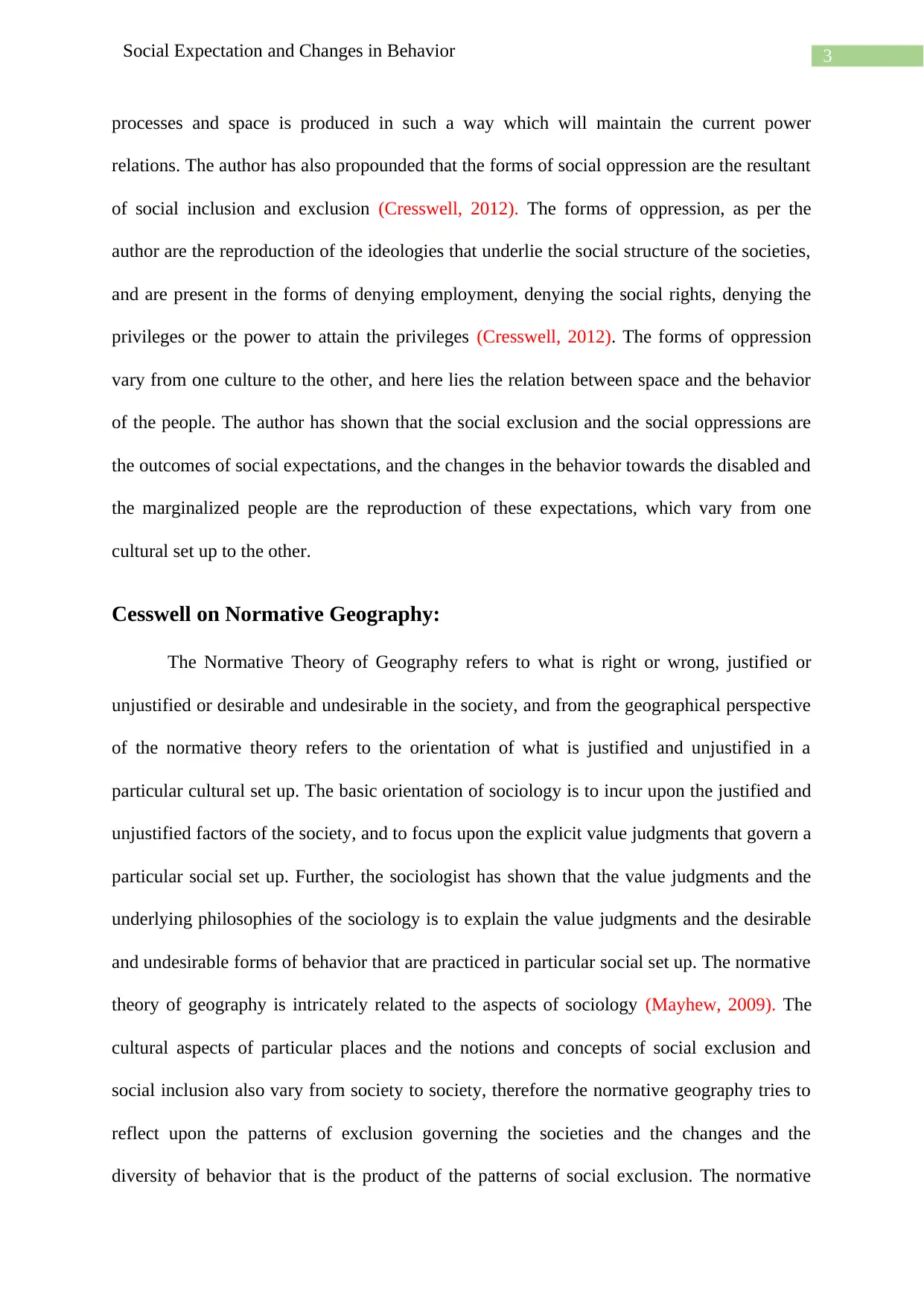
3Social Expectation and Changes in Behavior
processes and space is produced in such a way which will maintain the current power
relations. The author has also propounded that the forms of social oppression are the resultant
of social inclusion and exclusion (Cresswell, 2012). The forms of oppression, as per the
author are the reproduction of the ideologies that underlie the social structure of the societies,
and are present in the forms of denying employment, denying the social rights, denying the
privileges or the power to attain the privileges (Cresswell, 2012). The forms of oppression
vary from one culture to the other, and here lies the relation between space and the behavior
of the people. The author has shown that the social exclusion and the social oppressions are
the outcomes of social expectations, and the changes in the behavior towards the disabled and
the marginalized people are the reproduction of these expectations, which vary from one
cultural set up to the other.
Cesswell on Normative Geography:
The Normative Theory of Geography refers to what is right or wrong, justified or
unjustified or desirable and undesirable in the society, and from the geographical perspective
of the normative theory refers to the orientation of what is justified and unjustified in a
particular cultural set up. The basic orientation of sociology is to incur upon the justified and
unjustified factors of the society, and to focus upon the explicit value judgments that govern a
particular social set up. Further, the sociologist has shown that the value judgments and the
underlying philosophies of the sociology is to explain the value judgments and the desirable
and undesirable forms of behavior that are practiced in particular social set up. The normative
theory of geography is intricately related to the aspects of sociology (Mayhew, 2009). The
cultural aspects of particular places and the notions and concepts of social exclusion and
social inclusion also vary from society to society, therefore the normative geography tries to
reflect upon the patterns of exclusion governing the societies and the changes and the
diversity of behavior that is the product of the patterns of social exclusion. The normative
processes and space is produced in such a way which will maintain the current power
relations. The author has also propounded that the forms of social oppression are the resultant
of social inclusion and exclusion (Cresswell, 2012). The forms of oppression, as per the
author are the reproduction of the ideologies that underlie the social structure of the societies,
and are present in the forms of denying employment, denying the social rights, denying the
privileges or the power to attain the privileges (Cresswell, 2012). The forms of oppression
vary from one culture to the other, and here lies the relation between space and the behavior
of the people. The author has shown that the social exclusion and the social oppressions are
the outcomes of social expectations, and the changes in the behavior towards the disabled and
the marginalized people are the reproduction of these expectations, which vary from one
cultural set up to the other.
Cesswell on Normative Geography:
The Normative Theory of Geography refers to what is right or wrong, justified or
unjustified or desirable and undesirable in the society, and from the geographical perspective
of the normative theory refers to the orientation of what is justified and unjustified in a
particular cultural set up. The basic orientation of sociology is to incur upon the justified and
unjustified factors of the society, and to focus upon the explicit value judgments that govern a
particular social set up. Further, the sociologist has shown that the value judgments and the
underlying philosophies of the sociology is to explain the value judgments and the desirable
and undesirable forms of behavior that are practiced in particular social set up. The normative
theory of geography is intricately related to the aspects of sociology (Mayhew, 2009). The
cultural aspects of particular places and the notions and concepts of social exclusion and
social inclusion also vary from society to society, therefore the normative geography tries to
reflect upon the patterns of exclusion governing the societies and the changes and the
diversity of behavior that is the product of the patterns of social exclusion. The normative
Paraphrase This Document
Need a fresh take? Get an instant paraphrase of this document with our AI Paraphraser
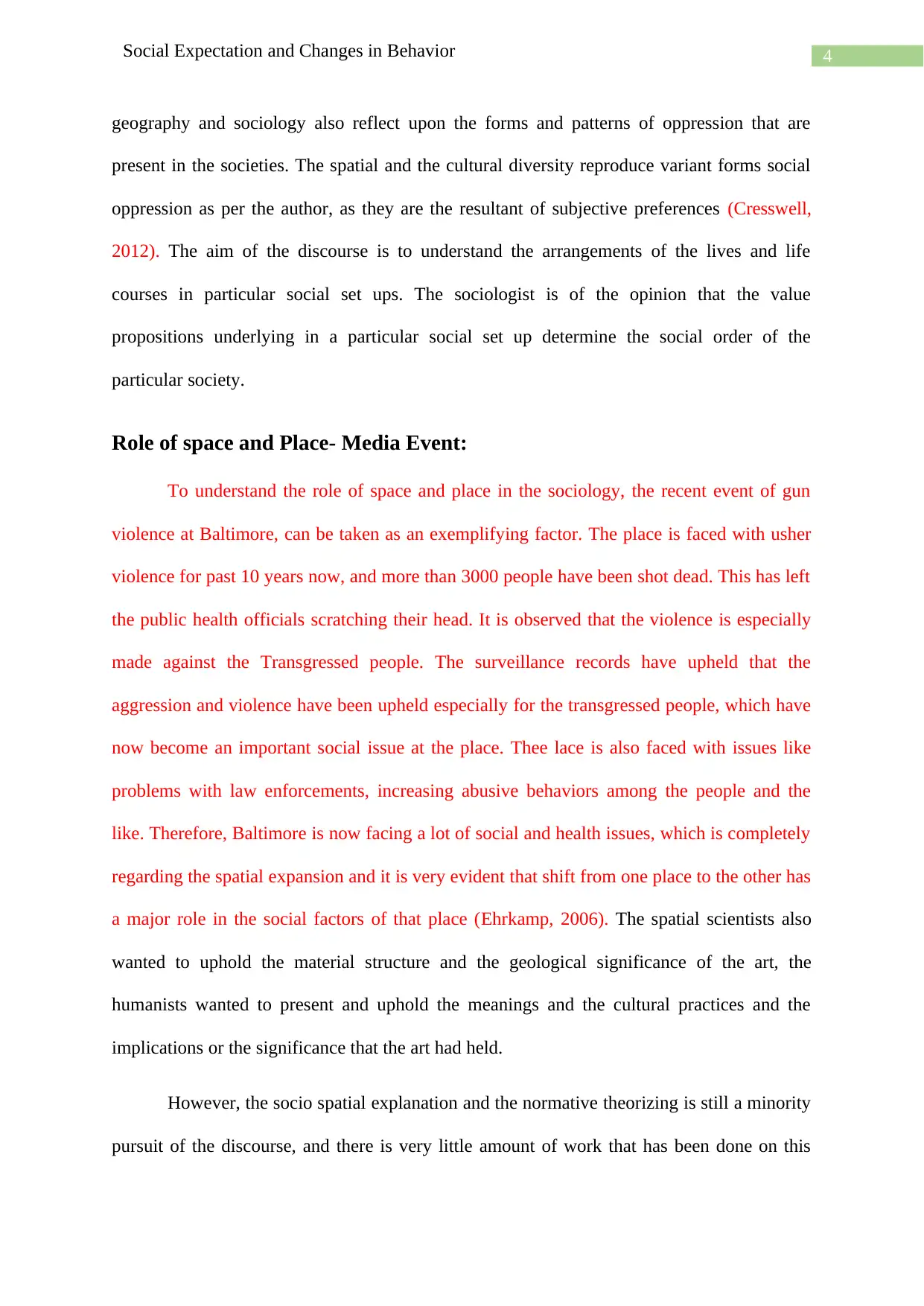
4Social Expectation and Changes in Behavior
geography and sociology also reflect upon the forms and patterns of oppression that are
present in the societies. The spatial and the cultural diversity reproduce variant forms social
oppression as per the author, as they are the resultant of subjective preferences (Cresswell,
2012). The aim of the discourse is to understand the arrangements of the lives and life
courses in particular social set ups. The sociologist is of the opinion that the value
propositions underlying in a particular social set up determine the social order of the
particular society.
Role of space and Place- Media Event:
To understand the role of space and place in the sociology, the recent event of gun
violence at Baltimore, can be taken as an exemplifying factor. The place is faced with usher
violence for past 10 years now, and more than 3000 people have been shot dead. This has left
the public health officials scratching their head. It is observed that the violence is especially
made against the Transgressed people. The surveillance records have upheld that the
aggression and violence have been upheld especially for the transgressed people, which have
now become an important social issue at the place. Thee lace is also faced with issues like
problems with law enforcements, increasing abusive behaviors among the people and the
like. Therefore, Baltimore is now facing a lot of social and health issues, which is completely
regarding the spatial expansion and it is very evident that shift from one place to the other has
a major role in the social factors of that place (Ehrkamp, 2006). The spatial scientists also
wanted to uphold the material structure and the geological significance of the art, the
humanists wanted to present and uphold the meanings and the cultural practices and the
implications or the significance that the art had held.
However, the socio spatial explanation and the normative theorizing is still a minority
pursuit of the discourse, and there is very little amount of work that has been done on this
geography and sociology also reflect upon the forms and patterns of oppression that are
present in the societies. The spatial and the cultural diversity reproduce variant forms social
oppression as per the author, as they are the resultant of subjective preferences (Cresswell,
2012). The aim of the discourse is to understand the arrangements of the lives and life
courses in particular social set ups. The sociologist is of the opinion that the value
propositions underlying in a particular social set up determine the social order of the
particular society.
Role of space and Place- Media Event:
To understand the role of space and place in the sociology, the recent event of gun
violence at Baltimore, can be taken as an exemplifying factor. The place is faced with usher
violence for past 10 years now, and more than 3000 people have been shot dead. This has left
the public health officials scratching their head. It is observed that the violence is especially
made against the Transgressed people. The surveillance records have upheld that the
aggression and violence have been upheld especially for the transgressed people, which have
now become an important social issue at the place. Thee lace is also faced with issues like
problems with law enforcements, increasing abusive behaviors among the people and the
like. Therefore, Baltimore is now facing a lot of social and health issues, which is completely
regarding the spatial expansion and it is very evident that shift from one place to the other has
a major role in the social factors of that place (Ehrkamp, 2006). The spatial scientists also
wanted to uphold the material structure and the geological significance of the art, the
humanists wanted to present and uphold the meanings and the cultural practices and the
implications or the significance that the art had held.
However, the socio spatial explanation and the normative theorizing is still a minority
pursuit of the discourse, and there is very little amount of work that has been done on this
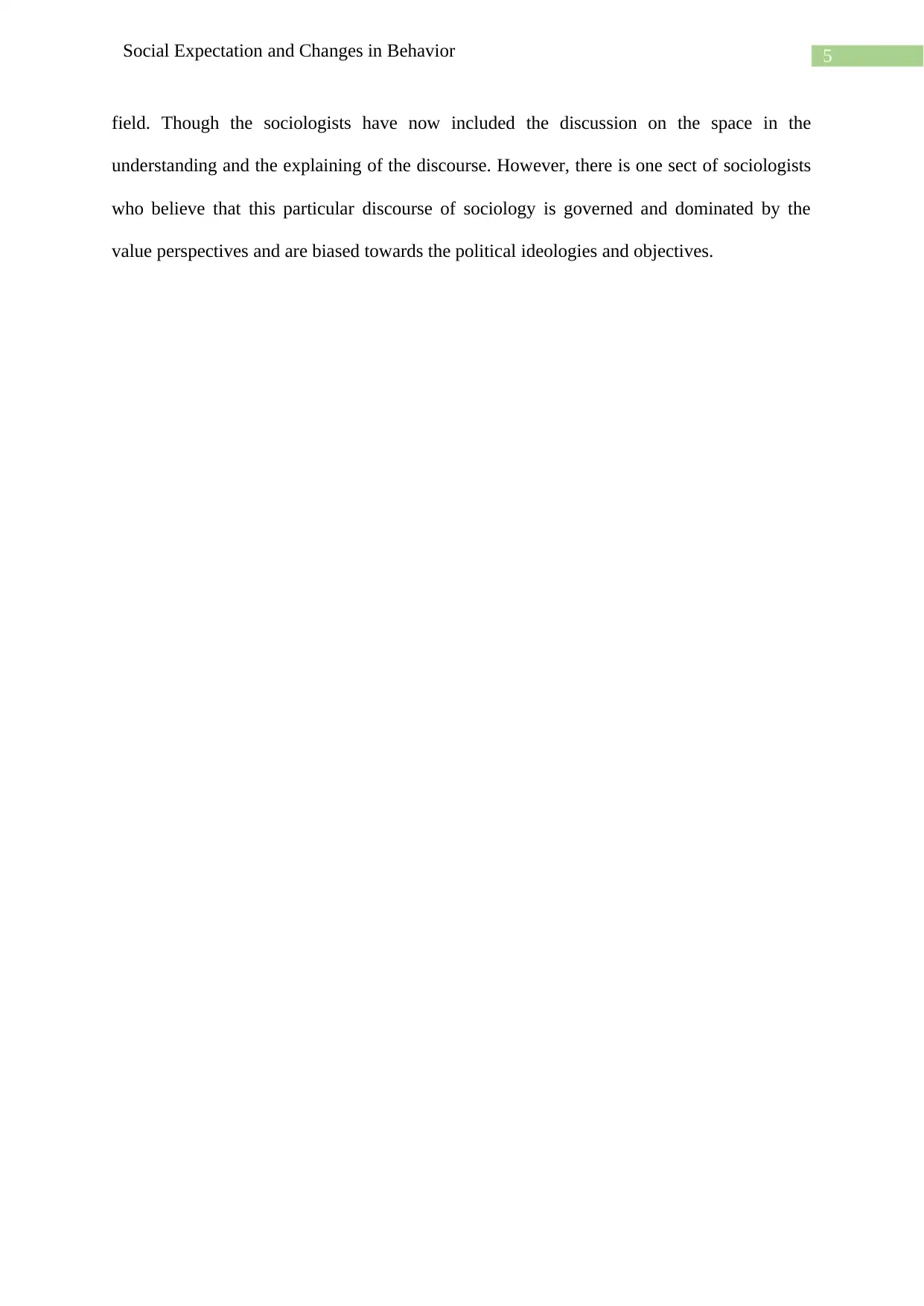
5Social Expectation and Changes in Behavior
field. Though the sociologists have now included the discussion on the space in the
understanding and the explaining of the discourse. However, there is one sect of sociologists
who believe that this particular discourse of sociology is governed and dominated by the
value perspectives and are biased towards the political ideologies and objectives.
field. Though the sociologists have now included the discussion on the space in the
understanding and the explaining of the discourse. However, there is one sect of sociologists
who believe that this particular discourse of sociology is governed and dominated by the
value perspectives and are biased towards the political ideologies and objectives.
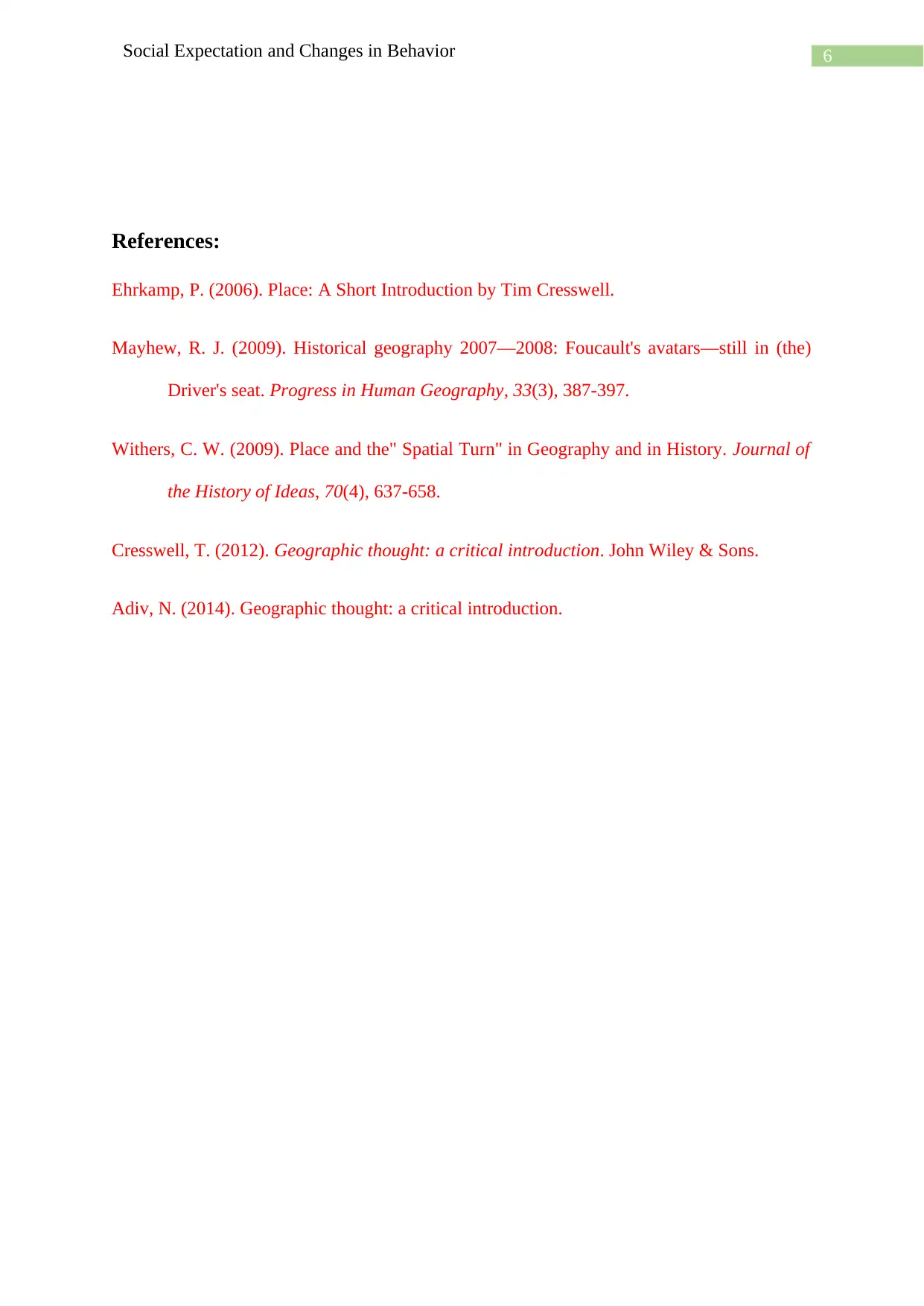
6Social Expectation and Changes in Behavior
References:
Ehrkamp, P. (2006). Place: A Short Introduction by Tim Cresswell.
Mayhew, R. J. (2009). Historical geography 2007—2008: Foucault's avatars—still in (the)
Driver's seat. Progress in Human Geography, 33(3), 387-397.
Withers, C. W. (2009). Place and the" Spatial Turn" in Geography and in History. Journal of
the History of Ideas, 70(4), 637-658.
Cresswell, T. (2012). Geographic thought: a critical introduction. John Wiley & Sons.
Adiv, N. (2014). Geographic thought: a critical introduction.
References:
Ehrkamp, P. (2006). Place: A Short Introduction by Tim Cresswell.
Mayhew, R. J. (2009). Historical geography 2007—2008: Foucault's avatars—still in (the)
Driver's seat. Progress in Human Geography, 33(3), 387-397.
Withers, C. W. (2009). Place and the" Spatial Turn" in Geography and in History. Journal of
the History of Ideas, 70(4), 637-658.
Cresswell, T. (2012). Geographic thought: a critical introduction. John Wiley & Sons.
Adiv, N. (2014). Geographic thought: a critical introduction.
1 out of 7
![[object Object]](/_next/static/media/star-bottom.7253800d.svg)





